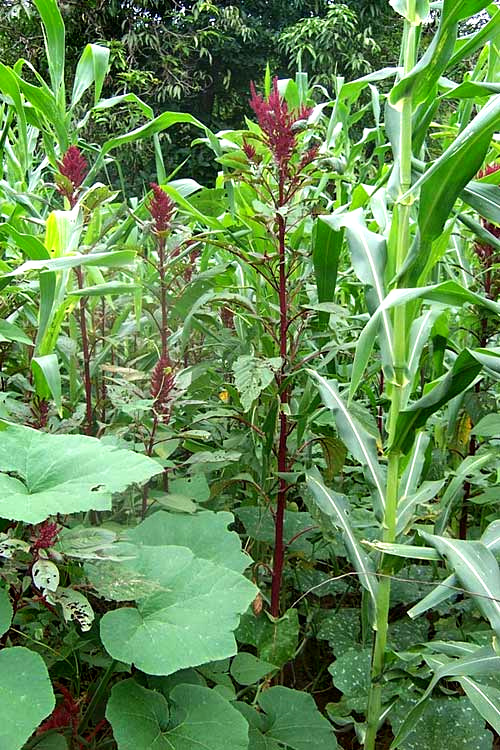Excerpts from Jim Conrad's
Naturalist Newsletter
from the September 14, 2007 Newsletter issued from Sierra Gorda Biosphere Reserve, QUERÉTARO, MÉXICO
CORN, SQUASH, BEANS & QUELITE
Across from a store where sometimes I buy my bananas there's a cornfield, a view into which you can see below:

Notice that the corn is much taller than what is grown in fields up north. I held the camera about five feet above the ground and you can see how the corn towers above the lens. At the picture's lower left the large, roundish leaves belong to squash plants. If you look closely below the squash leaves you can see trifoliate blades of bean vines. The purplish plants among the corn stalks are AMARANTHUS HYPOCHONDRIACUS, often known in English as Prince's Feather, while people around here call it Quelite. Quelite is a general name used for several similar potherbs. Amaranthus is the amaranth genus.
Before the corn got so tall, when the Quelite was knee-high with a more compact inflorescence and with leaves more succulent and closer together, it was perfect for being picked and cooked just as northerners cook wild poke or turnip and spinach greens.
Thus Quelite is growing among the corn not as a weed but as part of a sophisticated, traditional food-growing system. Don't forget that the bean-vine's roots bear nodules with mycorrhiza, which produce nitrogen for the other plants. This shaggy-looking garden space is very efficiently providing four nutritious and tasty food items.
The other day I visited a hut in the mountains where the señora was busily stripping Quelite leaves from purple stalks her little boy had brought home, surely from a cornfield like this. Back on the farm in Kentucky we had Amaranthus hybridus -- thus a member of the same genus as Quilite -- growing weedily in our garden and around the barn, and it also could have provided us with nutritious greens. However, we called it Pigweed and would have laughed, if not felt insulted, if someone had suggested eating it.